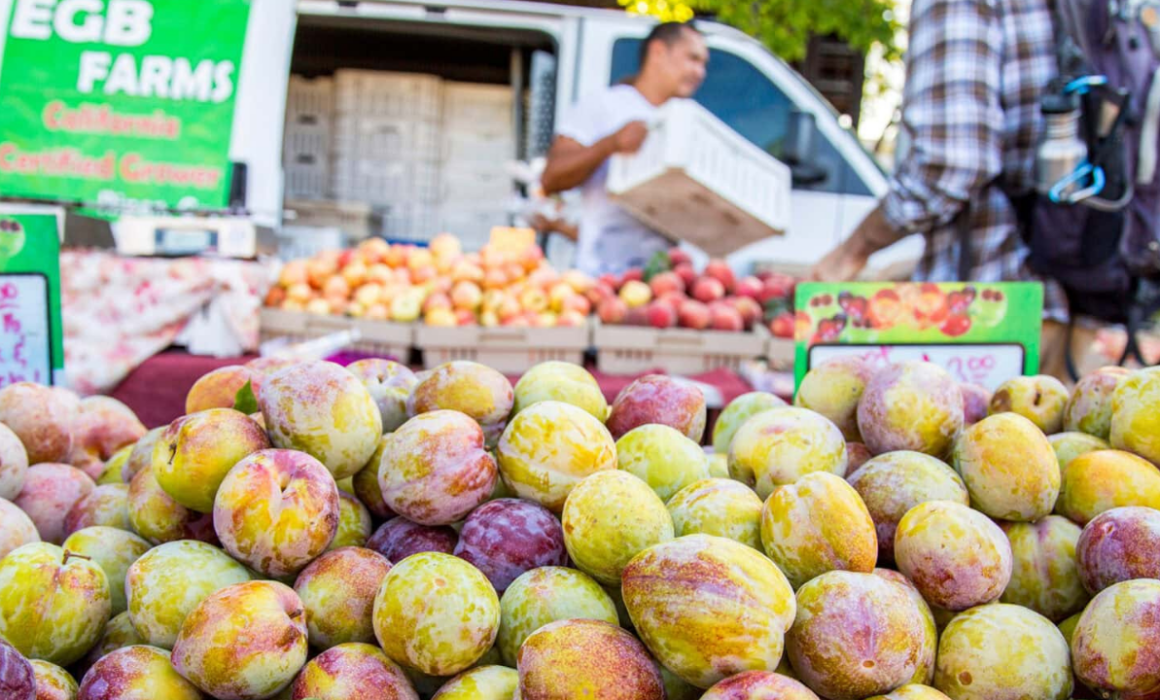Farmers’ Markets Boost Local Farmers
By Virginie Boone
The first farmers’ market in America on record took place in 1730 in Lancaster, Pennsylvania. Locals there have said, “Meet me at the Market,” ever since. The Lancaster Central Market in fact was built in the center of town as a focal point for the community. In 1995 it was designated one of our country’s “Great Public Places.”
Later, what became known as “curb markets” sprang up all over the burgeoning United States, a way for local farmers and merchants to set up their wagons on the curbs of streets to sell their goods to people in cities.
Farmers’ markets have continued to grow ever since, as both gathering places and sustainable market places. The USDA National Farmers Market Directory today counts more than 6,800 such markets operating across the United States. To be included, a farmers’ market must “feature two or more farm vendors selling agricultural products directly to customers at a common, recurrent physical location.”
The directory also lists farms, CSAs, agritourism destinations, on-farm markets and food hubs, places that aggregate and distribute local food products.
The Original Farmers’ Market in Los Angeles first opened in 1934 and is now a historic landmark, at the corner of Fairfax Avenue and Third Street. When it opened, the property was a 265-acre dairy farm. Local farmers started parking their trucks on a field selling their wares, paying fifty cents a day to rent a space. Part of the market’s lore is that James Dean had breakfast there on the morning of his deadly car accident in 1955.
The Alemany Farmers’ Market in San Francisco, founded in 1943, calls itself the first farmers’ market in California, started during World War II to support farms that were near the city, and is particularly known for carrying Latin and Southeast Asian ingredients.
During the war, another reason markets sprung up was due to a shortage of aluminum, which caused canneries to stop canning fruits and vegetables, which needed to be sold in other ways. Also, larger grocery markets preferred to buy in bulk, which made it harder for small-scale farmers to compete. There were also rations on gasoline at the time, so consumers couldn’t easily travel directly to farms on a regular basis, prompting farmers to come to them.
At the time though, the success of the farmers’ market was almost its undoing, as larger grocery stores complained that it affected sales. But in the end, voters voted to keep the farmers’ market and it, and many others, became a permanent fixture of city and suburban life.
California now has more than 650 certified farmers’ markets, 60% are year-round.
The Santa Rosa Original Certified Farmers’ Market was established in 1967, making it the oldest in Sonoma County. In its early days it was held on Petaluma Hill Road near the Crane Melon farm. It then moved to the Sonoma County Fairgrounds and later the Veterans Building (it has since moved again to a lot near the intersection of Highway 12 and Farmers Lane).
In the 1980s Hilda Swartz was an important figure in Sonoma County farmers markets. Swartz grew up on a 10-acre family farm in Southern California after the Great Depression years, growing peaches, cherries and table grapes.
She moved to Oakmont in 1979 and soon met Sara Lee Kunde and began working at the Harvest Fair. Later with Kozlowski Farms, Swartz started selling their wares at the Sonoma Farmers’ Market in 1985 and two years later was hired to run it, starting with just 10 vendors.
Soon, the growth of more farmers markets across the region helped Sonoma County become a famous place for not only wine grapes but all the other things it was growing so well on local farms.
In a December 1989 Los Angeles Times story called, “Stalking the Perfect Asparagus,” the area was described as a place where, “it is now possible to achieve some level of fame by growing vegetables… The demand for the most succulent zucchini and the crunchiest endive has reached such heights that vegetable growers get mentioned in the same breath with the Chardonnay vintners. One now ‘has vegetables’ the way one used to ‘have grapes.’”
The Healdsburg Farmers Market is one of California’s original 22 Certified Farmers’ Markets. There are now many more, including in Bodega Bay, Cloverdale, Cotati, Forestville, Oakmont, Occidental, Petaluma, Rohnert Park, Russian River, several in Santa Rosa, Sebastopol, Sonoma Valley, Sonoma, Windsor and Roseland.
The Certified part exempts farmers from packing, sizing and labeling requirements that had been in place until 1977 that required farmers to pack size and label their fruits, vegetables and nuts in standard containers to transport and sell anywhere other than their farm site, including farmers’ markets.
The Certified Farmers’ Market system gained them more flexibility, allowing farmers to interact directly with consumers, an increasingly important way for consumers to learn more about their local food supply.
California winegrowers holding a Type 02 license are able to sell wine at farmers’ markets with a special Certified Farmers’ Market Sales Permit so long as the wine is produced entirely from grapes or other agricultural products grown by the winegrower and bottled by the winegrower.
Here are just a handful of our local farmers’ markets:
Healdsburg Farmers Market – April 12 to December 20, Saturday 8:30 a.m. – 12:00 p.m.; May 13 – September 30, Tuesday 9:00 a.m. – 12:30 p.m.
Rohnert Park Farmers’ Market – June to August, 4:00 p.m. – 7:00 p.m.
Roseland Mercadito Farmers’ Market – Year-round Sunday 11:00 a.m. – 3:00 p.m.
Santa Rosa Certified Farmers Market – March to December, 8:30 a.m. – 1:00 p.m.
Santa Rosa Community Farmers Market – Year-round, Wednesday 9 a.m. – 1:30 p.m., Saturday 8:30 a.m. – 1:00 p.m.
Sonoma’s Tuesday Night Market – May through September
The Springs Community Farmers’ Market – September to November
Image by: Sonoma County Tourism


